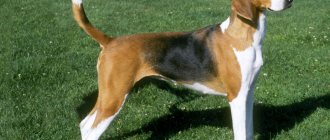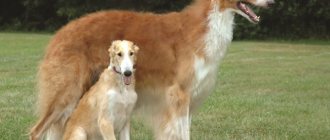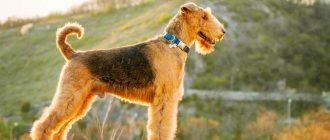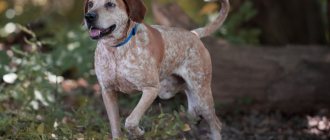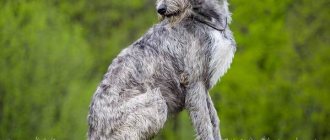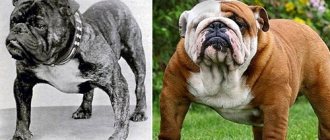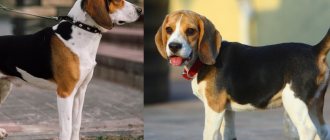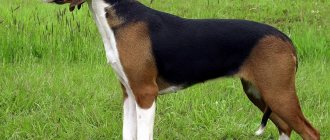The American Foxhound is one of the oldest breeds of hunting dogs bred in America. This is an energetic, cheerful fellow, well trained, large and hardy. Hunting is his passion. Even during a simple walk on the street, a foxhound can be attracted by some kind of smell, and he will begin to pursue prey, forgetting about everything else.
American Foxhound: description of the breed
Such a dog needs an owner with a similar character - active and athletic. The Foxhound is not a friend who can lie on the couch all day. At the same time, such dogs love children very much, and you can safely leave them instead of nannies.
What does an American Foxhound look like?
The American Foxhound looks leaner than its massive British ancestor. Dogs of this breed are tall, slender and have long beautiful legs. The muscles are strong and prominent, the body structure is athletic, the bones are light. The body is slightly elongated, it is tightly covered with elastic skin, the constitution is dry and strong.
The American Foxhound is softer than its English counterpart.
The sex of the animal is determined by its appearance: males are more massive and hardy than females. As for standards, the appearance of a purebred representative looks like this:
- Head. Elongated type, widening slightly between the ears. The skull is flat, there is a small “bump” on the back of the head. There is a small amount of excess skin on the muzzle that may bunch up, but not too much.
- Muzzle. It resembles a stretched rectangle with a straight bridge of the nose, with slightly hanging jowls covering the lower jaw. Lips are dark.
- Jaws. Powerful, with a full row of white teeth, very developed. The bite is correct, scissor-type. Two small symmetrical folds may form under the jaw. The nose pad is black, slightly pushed forward, and has a lot of receptors for a sensitive sense of smell.
- Eyes. The size is small, the shape is oval, the iris is brown. They look sad. A sad look provides the animal with a constant begging expression on its face.
- Ears. Very long and wide (longer than the British ancestor), strong, set rather low. They hang calmly on the sides of the head and reach almost to the nose.
- Chest and neck. The neck is sculpted, long, and goes into a muscular, strong torso, especially noticeable in the shoulder girdle. The withers are well developed and stick out noticeably upward. The chest is narrow, does not hang down too much, the ribs are not noticeable under the skin.
- Back. Stretched, straight, with muscles visible under the skin. The loin is strong, the croup is slightly sloping down. The abdomen closer to the groin area is strongly retracted.
- Tail. Long, sticks up, located at the middle level. The lower part is covered with coarser, short hair. It looks like a curved saber.
- Paws. The limbs are not as massive as those of the English Foxhound. The front legs are slender, set parallel, allowing the animal to accelerate well. The hind legs are straightened, flowing into elongated, muscular thighs. Paws with strong claws and dense pads are compressed into a strong round ball.
Males can boast a height of 55.9 to 63.6 cm, while females do not exceed 61 cm. Even taller individuals are allowed to perform at dog fights or shows: males - up to 71.1 cm, females - up to 66 cm. These stately the creatures look very impressive in the ring.
The parameters of a foxhound depend on its purpose
Weight fluctuates depending on the purpose and performance of the pet. Thus, most American Foxhounds weigh between 29-34 kg, but show animals can weigh much more, and representatives of hunting lines weigh no more than 21 kg.
Wool: quality and color
The body of the American Foxhound is covered with thick and coarse hair, similar to that of most other hound breeds. It is short, fits tightly to the body, and is smoother on the skull and ears.
The characteristic tricolor color is the identifying mark of the American Foxhound.
The color can be quite varied. The color of three colors is especially popular: on the main white shade there are areas of brown and black. There are also individuals of blue, red, yellow-brown and white colors.
general characteristics
The average height of Foxhounds is 60 centimeters and their weight reaches 35 kilograms. The average life expectancy is 10–12 years. The dog has a strong build, is agile, hardy, and fast.
The head is dry, medium in size, the skull is wide, the transition from the crown to the muzzle is quite pronounced. The muzzle is long, the nostrils are large. The sense of smell is poorly developed compared to other hunting breeds.
The eyes are medium-sized, round, mostly brown in color, and become fiery red when excited. Fox follows his prey, relying precisely on his excellent vision. The ears are of medium length, pendulous, set high and hanging flat. Foxhounds often have their ears cropped by 4 centimeters, rounding the ends.
The chest is deep, the ribs are rounded. The Fox's back is wide, with a long loin, and the croup is elongated, which gives the dog a wide, easy stride. The neck is long, strong, with a scruff. The teeth are sharp and strong, with a scissor bite.
The limbs are long, of the same thickness along the entire length, the metatarsus is short. The bones of the limbs are strong, with pronounced muscles. The toes are clenched tightly, the pads are hard, and the paws are called “cat paws.” The Foxhind's belly is tucked up.
The tail is of medium length, set high, saber-shaped and tapering towards the end. Except for birth defects, the Foxhound's tail is carried high up. The Fox's skin is elastic and fits tightly to the body. The coat is short, hard, dense and straight. The color of a foxhound can be quite varied. The predominant colors are grey, piebald, fawn and brown. Wool has an inherent shine.
Historical reference
The ancestors of the modern breed appeared in North America in 1650. These were several English foxhounds that were brought into the country by Robert Brooke, the head of Charles County. And the history of the development of hounds began.
Initially, the foxhounds showed negative results: this was their first time going overseas, where the landscape was unfamiliar and more rocky than in Britain. The adaptation was also aggravated by the frightening animals that were abundant in those lands - pumas, lynxes, wild boars and bears.
Foxhounds took time to get used to their new environment
120 years later, US ruler George Washington crossed the breed with greyhounds imported from Great Britain. This union created a new line called the Virginia Hound.
After testing, Washington decided that the bred individuals were not strong and hardy enough to hunt with him for a long time. With the help of the Marquis de Lafayette, they managed to bring blue Gascon hounds from France, who hunted moose there. The dogs attracted the breeder with their endurance and ability to keep track of their prey for a long time.
English Foxhound blood has survived many different experiments.
After this, numerous crossbreeding experiments began, which resulted in the original American Foxhounds. Later they were combined with hounds from Ireland, from which the breed received speed and even greater endurance.
Modern American Foxhounds are divided into several subgroups with their own characteristics.
Other breeders continued the experiments. It was possible to obtain and preserve to this day about 10 intrabreed varieties, different in appearance and characteristics. Thus, the Penn-Marydel line has a keen sense of smell and a melodious voice, the Trigg line dogs are hardy and obedient, and the Walkers line produces show dogs.
Breed recognition
The American Kennel Club approved new members in the last quarter of the nineteenth century, and the United Kennel Club in the early twentieth. The FCI got to the point of registering representatives of the new breed only 70 years later.
More than half a century ago, the American Hound was awarded the status of a state symbol.
After registration with the FCI, American Foxhounds began to gradually become known outside the borders of North America, but the population remains small. In 1966, the breed received the title of national symbol of Virginia, its homeland.
Origin
The foxhound or foxhound is a breed of dog that was formed in Great Britain in the 14th-15th centuries. Several types of greyhounds and hounds, popular at that time, were used in its selection, but even the exact number of original bloods is difficult to name. Reliable data has not been preserved in the sources, but there is information about the use of Talbots, Greyhounds, terriers and even bulldogs.
The reason for the appearance of a new breed was the changing fashion in methods of hunting animals. Horseback fox hunting became popular in England and dogs were needed that could withstand the speed of a horse's gait for a long time and were ready to work in a pack. By 1650, the phenotype and working qualities of the dogs were fully formed. The new hound was so popular that it was sent overseas to the USA. It was from these dogs that the population of American Foxhounds later developed.
It is known that the fox hound received its first family book back in 1786. But she had to wait much longer for the official standard. It was adopted in the 19th century with the advent of the era of exhibitions and sports competitions. Foxhounds also managed to prove themselves in the best way in them. Here a set of criteria was required by which dogs could be compared with each other within the breed.
Foxhound numbers reached their peak in the 19th century. There are 7,000 dogs registered in the UK alone. In Europe, these hounds were especially revered in France; here a large pack of them was kept at the court of Napoleon III. Club recognition of Foxhounds took place already in the 20th century. It was first officially approved by the UKC in 1905, and half a century later, in 1955, the FCI standard was developed. The number 159 assigned to the fox hound has not changed since then.
The purpose of the American Foxhound
In America, representatives of the breed were initially used as hunters of coyotes and raccoons, despite the fact that the name “Foxhound” literally means “fox hound”. For the United States, coyotes in those years were as much of a scourge as foxes in Britain.
The name "Foxhound" literally translates from English as "fox hunter"
Experts say that later red foxes were even specially brought to the United States so that foxhounds could fulfill their true purpose. Dogs also helped hunters pursue larger prey - wild boars, elk, and deer. And in the 17th century, the sensitive scent of fox hounds was used to track down Indians.
Contrary to their purpose, Foxhounds were used for the momentary needs of their owners
The main purpose of foxhounds is not to capture and kill the animal, but to search for it. After hunting was banned in some American states, the breed began to be used to participate in athletic competitions. Now hounds are devoted companions for their owners, helping in hunting ducks and small animals.
Nurseries
The English Fox Hound is a fairly rare breed outside of Britain. There are now about 300 working packs on the island where puppies can be purchased. A number of packs of Foxhounds can be found in Germany and Canada. But in Canada, English foxhounds are often mixed with American hounds, so the breed is rarely preserved there in its pure form.
People with an energetic personality type should buy an English Foxhound. This is a working breed, so this dog is not suitable for the role of just a pet. In addition, there are also difficulties in content. The animal requires excessive mobility, flocking, and frequent and long walks. However, for a keen hunter living in a country house, this is a suitable pet, a faithful assistant, and a friend.
https://prohvost.club/sobaki/porody-sobak/fokshaund-sobaka-foto.htmlhttps://givotniymir.ru/foksxaund-sobaka-opisanie-osobennosti-uxod-i-cena-foksxaunda/https://dogipediya. ru/porody-sobak/bolshie/anglijskij-fokshaund-foto-sobaki-osobennosti-porody
Breed characteristics and character
Foxhounds are distinguished by their fine sense of smell, high speed, and endurance. They perform well at exhibitions and various shows. Representatives of the breed are ideal companions for active owners who are able to provide the animal with plenty of space to release energy.
Foxhounds are open to interacting with both related hounds and other animals
What foxhounds are clearly not designed for is living in apartments. It is best to place pets in enclosures on private property. The Foxhound gets along well with other dogs, preferably with hounds.
Dog character
The American Foxhound loves to be independent and free. A wayward dog tends to ignore commands, run away from its owner and go on independent walks. Therefore, it is necessary to start training a puppy from an early age. He must understand commands, know what is allowed to him and what is prohibited under pain of punishment.
Foxhounds’ love of freedom cannot be overcome even with diligent training.
Representatives of the breed have the following traits:
- restraint, lack of aggression towards humans or other animals;
- poor disposition to training;
- quick adaptation to the owner, disinterested attitude towards guests;
- love for children: Foxhounds treat them with tenderness and playfulness;
- if necessary, they can act as a watchman and protector.
Foxhounds stand up for their owners, never losing their vigilance
Some Foxhounds may be wary of strangers, such as family guests. The dog monitors their actions to make sure that the stranger does not harm the owner and his family.
Health
The breed developed strong and healthy, thanks to its small numbers and proper selection. We can say that the painstaking infusion of new blood has benefited the breed.
A wide variety of ancestors allowed the Foxhound to avoid genetic diseases
American Foxhounds live on average 10-13 years, which is a pretty good indicator for a large dog, especially considering their hunting nature. Genetics turned out to be favorable, and among the breed diseases only a few can be distinguished:
- Pelger Huet pathology;
- thrombocytopathy;
- hypothyroidism;
- hip dysplasia;
- osteochondrosis;
- cricopharyngeal dysphagia;
- diaphragmatic hernia from birth.
The risk of congenital deafness, cryptorchidism and heterochromia is noted as non-dangerous pathologies.
Example of heterochromia
Even in puppyhood, each representative of the breed must receive vaccinations against rabies and major infectious diseases. This is especially important to consider for dogs hunting wild animals. The dog also needs to be regularly treated for parasites – internal and skin.
Since the Foxhound has its own genetic characteristics, medical examinations by a veterinarian will not be superfluous.
Important! It is advisable for the owner to show the pet to the Orthopedic Animal Foundation or the Dog Registration Foundation if breeding is expected. OFA and CERF tests are required to detect the presence of hereditary diseases that may affect the health of the dog or its babies.
general description
Since Foxhounds are hunting dogs, the best habitat is in a pack. In such conditions it is easier to raise a dog. Single foxes are more difficult to train and train, but are excellent companions for their owners. The owner's character must be persistent and strong, and the dog's training must be strict but calm.
Dogs raised in a pack love their owners and are distrustful of strangers, but do not show aggression for no apparent reason. A domestic dog with a high level of socialization, it behaves friendly, especially towards familiar people and animals. Fox quickly finds a common language with children, which is why he is often called a “nanny.” Other pets will also be surrounded by the care of the Foxhound. Universal love and affection make the foxhunter an affectionate and gentle friend of the family.
Foxes are balanced, but they require long and intense training. Living in an apartment will not be to his liking, and the dog may become depressed. The passion for hunting and a lot of energy require long walks or runs. The Fox needs to walk for several hours at a time. Dogs love to hunt and follow a scent, which allows them to realize their potential. This is vital for the Foxhound. Instead of hunting, you can take long bike rides or hikes.
The dog's sense of smell is poorly developed, but its vision is sharp, which allows Foxhounds to track prey without losing sight of it. Thanks to its vigilance, the foxgon will vigilantly monitor the home, preventing even small rodents from entering. But a Fox will not make a guard dog, since the dog’s character is quite soft and friendly. To raise a foxhound as a protector and guardian of a person, it is necessary to use special training methods.
Education and training
As already mentioned, American Foxhounds are difficult to train due to their willful disposition and habit of living in a dog pack, far from people. The dog is an ideal hunter, but often simply ignores the owner’s commands. During a walk, both the puppy and the adult dog must be held tightly by the leash - the hunting instinct in the Foxhound is so strong that if he is attracted by some smell, he will follow it, forgetting about everything.
Foxhounds are selfless pursuers, ready to forget about everything in pursuit of prey.
The American Fox Hound requires serious training, and novice breeders will have a hard time mastering the dog’s character. It is better to entrust this matter to specialists - this way you will be able to train the ideal hunter, who harmoniously combines natural instincts and skills acquired during training.
Taming a foxhound is not easy. It's worth starting from puppyhood
If you decide to raise your pet yourself, follow these important principles in training it:
- the owner needs to be demanding and persistent, develop a commanding voice;
- it is necessary to achieve compliance with orders in all possible ways (except for beatings - beatings will only make the dog cowardly and embittered);
- each pet requires an individual approach: some react to affection, others to a more severe attitude;
- do not allow a single indulgence: any indulgence will be noticed and the dog will stop obeying;
- the process of training (accustoming to poultry and livestock so that the dog does not perceive them as prey) must be carried out in puppyhood, since it will be difficult to wean an adult dog from this habit;
- It is important to wean your dog from approaching strangers and reacting to extraneous sounds.
It is important to distinguish a commanding voice from a shout - foxhounds will not tolerate it in their direction
For novice dog breeders, raising a Foxhound is an almost impossible task. Even experienced breeders find it difficult to achieve unquestioning submission and obedience from a dog of this breed.
American Foxhound price and owner reviews
Buying a representative of the breed is a difficult task, and it’s not just the high price. Breeders and kennels that keep American Foxhounds are extremely rare. It will take a lot of time to find a seller who has a good reputation.
The low prevalence of foxhounds in Russia is due to a lack of interest in their main skill - hunting
Hunting is not particularly common in Russian regions, so the breed has not gained popularity. It happens that the buyer has to wait until the female of a private breeder gives birth to offspring in order to buy one of the puppies.
Potential Foxhound owners should not think about a profitable financial deal either.
At the same time, the price of a dog may surprise even an ardent lover of hounds who does not skimp on animals. Thus, the average price of a puppy in Russia ranges from 800 to 1300 dollars (45,000 - 80,000 rubles). A lower price should alert the buyer: perhaps the breeder is trying to sell a puppy with pathologies or mixed blood.
The iconic nature of the Foxhound in American culture makes its export difficult.
In its historical homeland - the USA - you can buy a Foxhound much cheaper, but taking it out from there will be extremely problematic. This breed is recognized as a national treasure of the country, and this fact may become a completely justified refusal to export it abroad. The situation is similar with the export of gampra, which has recently become a national treasure of Armenia.
You can also read about the difficulties of acquiring an Armenian Gampr
The high price of a Foxhound indicates the need to approach the purchase responsibly
Important! The high price will scare away careless buyers who are not able to invest their souls and resources into raising a pet. You cannot get a Foxhound puppy just for beauty: you need to actively work with him, then he will become a good friend, an agile athlete or a hunter.
How to choose a puppy?
Even if a seller with a good reputation is found, an equally serious task remains - choosing a puppy. There are several important factors that will help you find a worthy friend and hunter:
- you should choose a puppy whose parents have high scores at shows and good scores in field tests;
- to raise a hunter, they buy a puppy 5-6 months old, but it is rare that a breeder keeps puppies of this age: usually they are taken out before two months;
- The sex of the baby should not influence the choice if further breeding is not planned: both females and males become equally good hunters;
- the baby should develop according to his age, look healthy, energetic and love games;
- The little hunter should have dark eyes, a black nose pad and a correct bite.
Foxhound puppies sell out instantly, so it can be difficult to make a balanced purchase.
Since scarce puppies are taken apart at the age of 1.5-2 months, even dog experts will not tell about their future character during this period. Therefore, most often, puppies are selected based on the characteristics of their parents: their working qualities and external characteristics.
Caring for Drahthaars
The Drathaar is a fairly unpretentious breed. A dog can live either in a house or apartment, or in an enclosure. She is also not particularly picky about food. You can bathe your dog with shampoo 2-3 times a year, or you can not do it at all. As for the claws, most often their trimming is not required for the simple reason that they grind down on their own.
If the dog's owner is a great esthete, then caring for it can be made more civilized. For example, do regular examinations of the ears, eyes, paw pads, partitions between the toes, and strengthen antiparasitic measures to prevent infection by helminths and ticks. You can also constantly monitor the appearance of the coat. This is especially true during the molting period or if the dog regularly takes part in exhibitions.
It is important to understand that the structure and thickness of the coat varies among different representatives of the breed, which, in fact, determines the severity of shedding. For the animal's coarse and long fur, regular brushing is necessary. If this is not done, excess undercoat may form, and the guard hair will not fall out completely during the molting process.
It is highly advisable to trim the hair on the head of puppies and juniors that is too soft before the age of one year. The same applies to too long hair, because it will greatly interfere during the hunt.
If this is not done, then excess undercoat may form, and the guard hair will not fall out completely during the molting process. It is highly advisable to trim the hair on the head of puppies and juniors that is too soft before the age of one year. The same applies to too long hair, because it will greatly interfere with hunting.
Drathaars are not at all afraid of water and love to swim in bodies of water, so you should not deprive them of this opportunity, since a constant excess of energy requires an outlet. Dogs also love to engage in any sport: running, jumping, playing catch.
How and what to feed the American Foxhound?
Feeding should be organized so that the pet receives all the vitamins and nutrients it needs. Due to their activity, hounds require a balanced diet with vitamins and minerals. Only ready-made dry food of the premium and superpremium categories can fully supply your dog with them.
Lack of vitamins in food is most dangerous for growing puppies.
Important! You should not give your foxhound cheap industrial food, as their composition is not suitable for the dog’s complex body. They cause intestinal disorders and make the coat dull.
In addition to balanced feed, natural foods are allowed:
- boiled lean meat (turkey, chicken, beef), cut into small cubes, no more than 250 g. in a day;
- porridge (oatmeal, buckwheat/rice);
- greens and vegetables as additional vitamins.
The pet's food is always given fresh. This needs to be monitored especially carefully in the summer, because due to the heat, food quickly deteriorates and can cause enteritis, diarrhea or other gastrointestinal disorders in the dog.
Despite his love of movement, the Foxhound can quickly gain weight if not fed properly.
Representatives of this breed are prone to being overweight, so you need to strictly follow a diet and do not feed your pet food from the owner’s table. A fat pet will not be able to run fast and be a good hunter.
Important! If your pet has had lunch and there is still food in the bowl, it should be placed in a container and put in the refrigerator until the next feeding. The dog needs to be weaned from the habit of leaving food for later.
Tips for feeding puppies from birth to the sixth month are discussed below.
Diet for a foxhound puppy
Care
Foxhounds are pack dwellers and are not used to special care. It is enough to bathe the dog when it gets dirty and comb out the thick fur with a stiff bristle brush. The dog's shedding is moderate and occurs twice a year. You especially need to take care of your dog’s ears and clean them regularly.
Like any purebred dog, the Fox needs vaccinations and regular visits to the veterinarian.
Although country life suits the Foxhound like nothing else, his short coat does not allow him to survive severe frosts without constant movement. Therefore, in winter, the dog must live in a house or an insulated booth. To rest, the foxcat needs a spacious place, that is, the size of the booth must be appropriate.
Foxes are unpretentious when it comes to food, but the foxcat's diet should be balanced and moderate. Overfeeding will turn a sport hunter into a weakling, completely depriving him of the joy of life.
Foxes are quite hardy and healthy from birth; diseases arise precisely against the background of overeating and excess weight. The most common disease is gastric volvulus. In addition to problems with the digestive tract, dogs can experience diseases of the joints and spine.
This breed feels best in the company of its brothers, so it is advisable to have two Foxhounds at once. This will make life easier for the owner, since the Foxes themselves will keep each other company both at home and on walks.
How to walk a foxhound?
The American Foxhound requires regular exercise and long runs at high speed. The best pastime for them is jogging through the forest; in extreme cases, you can provide them with free walks during the day. But these active athletes will definitely not have enough quiet 20-minute walks in the morning, which owners organize for less active dogs.
Proper calculation of daily physical activity allows you to keep your pet in shape.
Because of their long legs, Foxhounds can easily overcome obstacles and run very quickly. But if the dog doesn’t get enough physical activity, he will quickly get fat and begin to have difficulty moving.
Teaching your foxhound that food doesn't last forever will help keep his digestion normal.
Important! You shouldn’t leave your pet at home alone: a dog full of untapped energy can create such a mess that the owner will have to throw out half of his things. If you leave a Foxhound alone in a summer cottage, he will quickly learn to open the valves and take an independent walk. Only regular exercise can cure him of such habits.
Hunting with a Foxhound
During the hunting process, the American Foxhound is used in four different ways, which require different levels of training and skills:
- Field trials where Foxhounds compete as hounds against other hounds. Here their reaction speed and efficiency are tested.
- “Gun” pursuit of foxes, in which the dog drives the prey, preparing it for a meeting with the shooter. The hound is required to run slowly and have a loud bark in order to chase the fox.
- Track hunting, where foxhounds appear as fast hounds. The dog simply tracks the game, using its speed and ability to carry out long-term exercise.
- Hunting hounds in a team. From 15 to 20 dogs participate. As a rule, a whole community of breeders or an association of foxhound lovers participates in such mass hunts.
Gradually, the foxhound moves from the status of a hunter to the role of a companion and guardian of the family.
Today, the American Foxhound is gradually losing its narrow specialization as an assistant in hunting. It is increasingly being domesticated due to its close coexistence with humans, which was initially unusual for the dog’s nature. Now the Foxhound is perceived as an energetic pet that everyone in the family, including small children, goes crazy for.
Popular hunting breeds
The American Foxhound is not the only popular representative among hounds. Within this group, there are many distinct hunting breeds that are trained to seek out prey and chase it down with loud, booming barks.
The Foxhound has many colleagues who are not inferior to him in hunting abilities.
At the same time, not all hounds look like a lean foxhound, muscular and prominent, showing with all their appearance their energy and lightning-fast reaction. So, other representatives can be so original in appearance that you won’t immediately understand that this is a hound.
Table 2. The most prominent representatives of hounds
| Breed | Description |
Basset Hound | The dog of this breed is large, with short legs, lazy in appearance and with an indifferent look. He has a heavy body, which suddenly becomes agile, fast and energetic, as soon as he smells game |
Spanish hound | Representatives of the breed help in chasing hares, foxes, wolves and even wild boars. They can be part of a pack, but more often they work alone, complementing the owner-hunter. The Spanish hound can chase prey for several hours in a row, and after a short rest, continue the pursuit again. |
Anglo-French small hound | Distinctive features of the breed are high performance, lightning-fast reaction and endurance. Just like foxhounds, they cannot tolerate boredom or rest at home. They need hunting and active games. Capable of equally successfully hunting hares, raccoons, foxes and large animals - bears, wolves, large wild boars |
Beagle | Little gambling animals, which were appreciated by American and British breeders hundreds of years ago. The cheerful disposition of these dogs is gradually winning over Russian dog breeders. The Beagle is a hound that can work on both small and large animals. A keen sense of smell allows these representatives of the hunting family to quickly and easily find prey |
Dossier
Other possible names: English foxhound, parfors foxhound, English parataya hound. Adult height: 57-65 cm. Weight: 26-36 kg. Characteristic color: lemon piebald, white with black spots in blush. Coat length: short, close-lying. Life expectancy: 11-15 years. Advantages of the breed: friendly, hardy, energetic, independent, determined, gets along well with children and pets. Easily withstands exhausting jumps over rough terrain with frequent obstacles, while easily developing an average speed of 20 to 25 km/h. Difficulties of the breed: constant support of an active lifestyle. The scent of this breed is slightly weakened due to the fact that the fox, which is the main object of hunting, has a rather pungent odor. Average price: approximately from $400. Classification:
- group: hounds and related breeds;
- section: hound;
- subsection: large hound.
